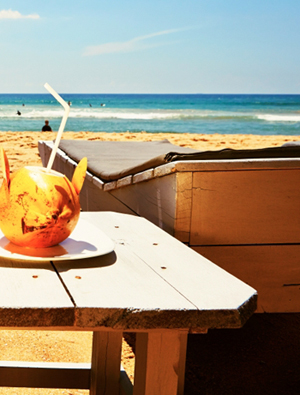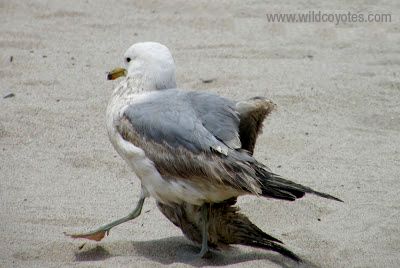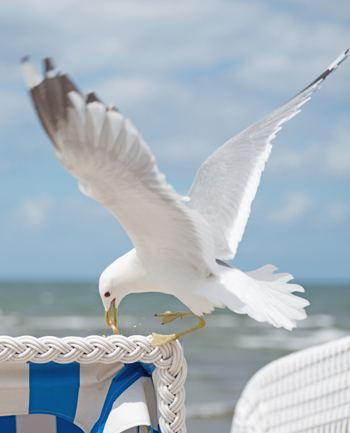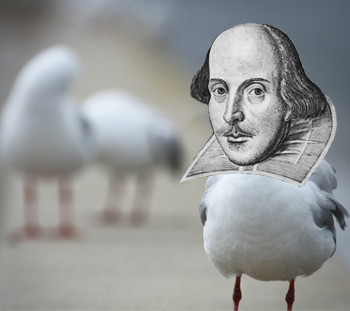Gull-ture
We are pleased to have as a Behavior Watch guest commentator Jim Cook, a doctoral candidate in behavior analysis at West Virginia University. He takes us to the beach for some observations of unusual behavior in sea birds and clever speculation as to how it may have come about. If you find Jim’s observations interesting, also check out the following commentaries on the Institute’s web site: “Are We Superstitious about ‘Superstitious’ Behavior?” and “You Get What You pay For: More on Shaping Behavior.” Both of these commentaries describe how shaping brings behavior about, either on purpose or accidentally. To these observations, Jim adds the idea of how cultures pass on learned responses. If you have seen unusual behavior like he describes in your pets or in animals in their natural habitats, we would love for you to leave us a comment.
 This past summer I had the opportunity to travel to St. Thomas for a friend’s wedding. The whole affair was lovely and everything went off without a hitch (save for the two folks successfully gettin’ hitched.) Though celebrations of two people coming together are great and all, they only take up so much time, and I had a few more days to kill. This was a good problem to have and one easily solved by some combination of beach chair and rum.
This past summer I had the opportunity to travel to St. Thomas for a friend’s wedding. The whole affair was lovely and everything went off without a hitch (save for the two folks successfully gettin’ hitched.) Though celebrations of two people coming together are great and all, they only take up so much time, and I had a few more days to kill. This was a good problem to have and one easily solved by some combination of beach chair and rum.
While solving my problem one evening, I took notice of one of the local gulls. It was a laughing gull with a white body and black head and wings, just like the countless others all over the island. There at the resort, the gulls behaved much like pigeons, squirrels, and other wild animals that live where people are often present: They keep their distance from the people, occasionally sneaking forward to snatch a morsel of food before being shooed away by the staff. I happened to notice this particular gull because it was dragging one of its wings along the ground. I watched it walk along the shore, leaving a thin trail in the sand where its wing touched the ground.
 I pointed the injured gull out to my friends. They said variations on “Aww, that’s so sad,” and “What’s going to happen to him?” I replied with variations of “Yep,” and “Probably get eaten by a cat.” Animals that show obvious injury tend to be noticed by predators and get picked off. I figured a gull with an obviously broken wing wouldn’t last long. I watched the gull wander this way and that, and then start towards the pool area where there were more people. That was odd. I wouldn’t expect an injured animal to approach humans.
I pointed the injured gull out to my friends. They said variations on “Aww, that’s so sad,” and “What’s going to happen to him?” I replied with variations of “Yep,” and “Probably get eaten by a cat.” Animals that show obvious injury tend to be noticed by predators and get picked off. I figured a gull with an obviously broken wing wouldn’t last long. I watched the gull wander this way and that, and then start towards the pool area where there were more people. That was odd. I wouldn’t expect an injured animal to approach humans.
The gull began to pace among the people, its wing dragging along beside it. Eventually folk near the gull began saying variations of “Aww, that’s so sad,” and “What’s going to happen to him?” and “We should do something to help him.” They’d approach him, and the gull would back away, flapping its good wing in a vain attempt to fly off. Dismayed by their inability to get close to the gull without distressing it, they’d try to give the gull some solace by tossing the gull a french fry or chip. An act of charity the injured gull readily snapped up.
The newlyweds happened by at that moment, and I pointed out the gull to them. “He’s faking,” the groom said. “I watched him last night fly in and then start dragging his wing. People would toss him food and eventually he took off. I should have mentioned it earlier; I thought you’d find that interesting.”
 I did. If that was true, I’d only seen half this gull’s act so far. I wanted to see if the other part was as advertised. I approached the gull.
I did. If that was true, I’d only seen half this gull’s act so far. I wanted to see if the other part was as advertised. I approached the gull.
It started backing away, its good wing beating the air.
I approached.
“Kee-agh!” it squawked, hopping backwards.
I approached.
The gull let out another squawk, hopped, and with both wings, lifted itself into the air and away.
As the trip went along, I found that it wasn’t just that gull pulling this act. I’d see one gull or another, fly in from the sea, gently land upon the shore, drop its wing, and head towards any nearby people, tracing its path in the sand with the tip of its “lame” wing. They’d wander along the beach or into the pool area, get a snack from some gentle soul, and take off. Sometimes I’d see two or more doing this at the same time, making this farce all the more transparent.
How could such an odd behavior come about? I doubt some behavior analyst, bored out of his mind lounging about in a tropical paradise took it upon himself to shape this behavior by reinforcing successive approximations of faking a broken wing. I mean, that’d work, but then he’d have to repeat it with all the other malingering gulls.
Maybe instead, once upon a time, there actually was a laughing gull with an injured wing. It crashed to the shore and happened into the resort where someone took pity upon it and tossed it a bit of food. Maybe the injured gull got by for a time this way, surviving off the scraps people tossed its way. Maybe then, the other gulls saw this and began to imitate the injured gull. Imitation is a skill that is within many animals’ repertoire. It’s how predators learn to hunt, songbirds to sing their distinctive songs, and people learn to do quite a bit. The injured gull served as a model for the other gulls, the other gulls imitated the injured gull, and because I doubt many people can tell one gull from another, the gull that faked the injury got itself an easy french fry. Pretty soon, you’d have an entire community of malingering gulls. The behavior of faking a broken wing would get passed on from one gull to another well past the time the gull that was actually injured was probably picked off by a cat. This behavior would get passed along in much the same way that setting out a tips or donation jar took off in American life. The first person to set one of those out is probably long gone, but that behavior persists in our culture because it is reinforced by people giving money. Faking a broken wing may now be embedded deep in certain gull cultures as well. “Gull-ture” if you will.
If that’s the case, maybe we could steer their behavior towards something a little more constructive than just hustling us for a chip. I’ve seen them act. They were convincing. I’m willing to pay to see a bit of Shakespeare (“Gullspeare?”) on the beach.




